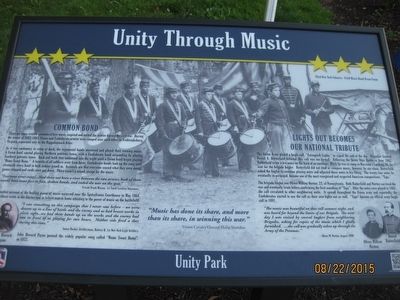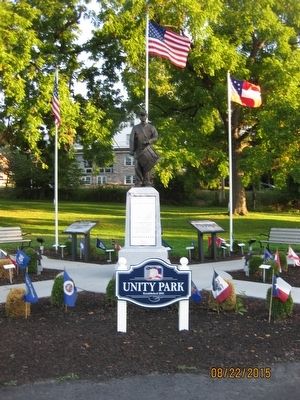Gettysburg in Adams County, Pennsylvania — The American Northeast (Mid-Atlantic)
Unity Through Music
Unity Park
"Music has done its share, and more than its share, of winning this war"
Union Cavalry General Philip Sheridan
Common Bond
There are many written accounts of how music inspired and united the armies during the civil war. During the winter of 1862-1863, Union and Confederate armies were camped near each other in Fredericksburg, Virginia, separated only by the Rappahannock River.
As was customary in camp at dusk, the regimental bands mustered and played their evening music. A Union band started playing Northern patriotic tunes, with a Confederate band responding by playing Southern patriotic tunes. Back and forth they continued into the night until a Union band began playing "Home Sweet Home". A favorite of all soldiers away from home, Confederate bands took up the song until eventually every band in both armies joined in. Accounts are that everyone ceased what they were doing; games stopped and cards were put down. There wasn't a sound, except for the music.
"Everyone went crazy!...had there not been a river between the two armies, both of them would have come face to face, shaken hands and ended the war on the spot"
Private Frank Mixson, 1st South Carolina Volunteers
Another account of the healing power of music occurred near Spotsylvania Courthouse in May 1864. Soldiers wrote in the diaries and in letters sent home attesting to the power of music on the battlefield.
"I saw something on this campaign I never saw before - we were drawn up in a line of battle and the enemy and us had breast works in plain sight...we had three bands up on the works and the enemy had two in front of us playing for two hours. Neither side fired a shot during this time"
James Decker, Artilleryman, Battery B, 1st New York Light Artillery
John Howard Payne penned the widely popular song called "Home Sweet Home" in 1822.
Lights Out Becomes Our National Tribute
The Union Army played a bugle call, "Extinguish Lights" , to signal the end of the day. Brigadier General Daniel A. Butterfield believed this call was too formal. Following the Seven Days Battle in June 1862, Butterfield wrote a few notes on the back of an envelope. While he was in camp in Harrison's Landing, VA, he send for the brigade bugler. Butterfield did not read or compose music, however, by ear alone, Butterfield asked the bugler to continue playing notes and adjusted those notes to his liking. The twenty-four notes he re-arranged became one of the most recognized and respected American compositions, "Taps".
The brigade bugler was Oliver Willcox Norton, 23, of Pennsylvania. Both Butterfield and Norton survived the war and eventually wrote letters confirming the first sounding of "Taps". After the notes were played in 1862, the call circulated to other neighboring units. It spread throughout the Union army and reportedly the Confederates started to use the call as their lights out as well. "Taps" became the official army bugle call in 1891.
"The music was beautiful on that still summer night, and was heard far beyond the limits of our Brigade. The next day I was visited by several buglers from neighboring brigades, asking for copies of the music which I gladly furnished. ...the call was gradually taken up through the Army of the Potomac"
—Oliver W. Norton, August 1898
(caption)
(background) 93rd New York Infantry - Field Music Band Drum Corps
(lower left) John Howard Payne
(lower right)Oliver Wilcox Norton; Daniel Butterfield
Erected 2015.
Topics. This historical marker is listed in these topic lists: Arts, Letters, Music • War, US Civil. A significant historical year for this entry is 1862.
Location. 39° 49.52′ N, 77° 13.822′ W. Marker is in Gettysburg, Pennsylvania, in Adams County. Marker is at the intersection of Lefever Street and Wainright Avenue, on the right when traveling east on Lefever Street. Located 60 yards east of Baltimore Street in Unity Park. Touch for map. Marker is in this post office area: Gettysburg PA 17325, United States of America. Touch for directions.
Other nearby markers. At least 8 other markers are within walking distance of this marker. Unity Park (here, next to this marker); Communications Through Music (here, next to this marker); History of American Field Music (here, next to this marker); Dr. Rufus Benjamin Weaver (a few steps from this marker); The Old Well (within shouting distance of this marker); The Evolution of Gettysburg's "Common School" (within shouting distance of this marker); Baltimore Street: An Historic Corridor (within shouting distance of this marker); "if anyone showed himself…" (within shouting distance of this marker). Touch for a list and map of all markers in Gettysburg.
Credits. This page was last revised on June 4, 2020. It was originally submitted on August 29, 2015, by Bill Donovan of Maplewood, New Jersey. This page has been viewed 373 times since then and 12 times this year. Photos: 1, 2. submitted on August 29, 2015, by Bill Donovan of Maplewood, New Jersey. • Bernard Fisher was the editor who published this page.

